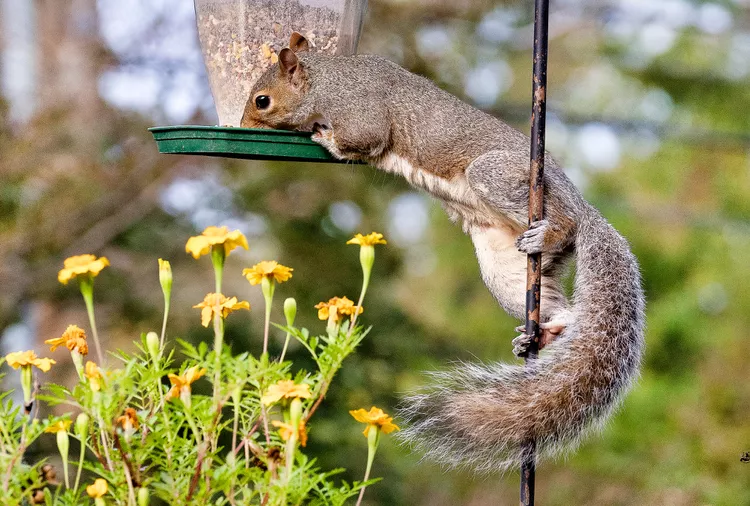Hanging up a bird feeder is a great way to attract birds to your backyard, but you may find you have more than feathered friends visiting. Knowing how to keep squirrels out of bird feeders will help prevent these cute but messy creatures from gobbling up all your seeds and scaring away birds. These expert tips will help you choose the best types of feeders, accessories, and placement to keep squirrels away.
- Jen McGuinness is the author of Bird-Friendly Gardening and Micro Food Gardening.
- David Mizejewski is a naturalist with the National Wildlife Federation and the author of Attracting Birds, Butterflies, and Other Backyard Wildlife.
1. Add a baffle.
A baffle is a metal or plastic structure you place over a feeder to block squirrels or other critters from accessing the feeder. “Baffles can deter squirrels from accessing the feeders from below or above,” says Jen McGuinness, author of Bird-Friendly Gardening and Micro Food Gardening. Baffles are typically dome- or cone-shaped and can be purchased or homemade.
“They are typically circular and wide and made of smooth plastic that squirrels cannot grip,” says David Mizejewski, author of Attracting Birds, Butterflies, and Other Backyard Wildlife. “You can also place a smooth plastic or metal pipe around the pole to serve the same purpose.”
Before adding a baffle, consider where your feeder is located in relation to squirrel access points. “If your feeders are accessible from an area a squirrel can jump from—such as a shed or a tree—having a baffle will not help,” McGuinness adds.
2. Choose squirrel-proof bird feeders.
Some bird feeders are designed to keep critters out, including weight-sensitive feeders or those designed only to be accessible for bird-sized visitors. “A feeder surrounded by a mesh cage with openings large enough for small birds to fit through but not squirrels is one type,” says Mizejewski.
A weight-sensitive feeder shuts if a squirrel or other critter jumps onto it. “Using a feeder that will close the feeder ports when extra weight is on the feeder is one way to discourage squirrels,” says McGuinness. You don't have to worry about the birds being shut out of accessing birdseed. “Birds are much lighter than squirrels and don’t trigger the shutting mechanism,” says Mizejewski.
3. Hang the feeder on a pole.
“Squirrels are excellent climbers, so hanging a bird feeder from a tree branch is not a good idea if you don’t want them to take advantage of it,” says Mizejewski. A better option is to hang a bird feeder from a pole. “Mount your feeder on a pole fitted with a baffle to prevent squirrels from climbing up it,” says Mizejewski.
If you choose this method, ensure the pole is installed well. “You want to make sure the bird feeding pole is securely in the ground and won’t tip with the weight of the feeders or during a heavy storm,” says McGuinness.
4. Hang bird feeders high.
If you want to outsmart a squirrel, hang the feeder out of reach. What's a good height to hang a feeder? “A feeder at least 6 feet from the ground is a great way to discourage access,” says McGuinness. She adds that you can also place it higher than 6 feet, but you might need a hanger to reach it. “I use a long hook to hang the feeders on my feeder stations in my garden,” she says.
5. Add hot pepper to the birdseed.
Sprinkling cayenne pepper on the birdseed is another option to deter squirrels. “Birds aren’t affected by capsaicin, the chemical in hot peppers that causes a burning sensation, but mammals are,” says Mizejewski. If you’re worried about the squirrels or other critters, they won’t be harmed. “While it won’t do any permanent harm, a squirrel that eats hot pepper-coated seeds experiences an unpleasant burning sensation and quickly learns to avoid the feeders,” he adds.
This technique is worth trying, but it may not be 100 percent effective. For example, McGuiness hasn’t had success with this tactic. “I have not had luck using the birdseed mixed with cayenne pepper or chili flakes,” she says. Very determined squirrels may not be deterred.
6. Place bird feeders away from objects.
“Squirrels are great problem solvers, so when hanging or mounting your feeders, analyze whether there are any structures, trees, or shrubs that squirrels can jump from to access the feeder are nearby,” says McGuinness. Placing a feeder at least 6 feet high may be a rule of thumb, but you also need to consider potential objects squirrels can use to reach their prize: the birdseed. “Feeders should be placed 8 to 10 feet away from other objects to minimize the opportunity for squirrels to jump onto the feeder,” she says.
7. Remove access points.
You also need to assume a squirrel’s perspective and check for any easy access points they can scurry along and jump to reach the bird feeder. “Make sure there is nothing along the ground that they can use to jump from, such as a decorative garden statue or a large planter,” says McGuinness.
8. Use a seed tray.
Place a seed tray below the bird feeder so fewer seeds end up on the ground when birds come to feast. “Seed trays catch seeds that birds may sift and toss to the side,” says McGuinness. She adds that house sparrows do this. Another benefit of seed trays is that they provide a place for birds to land. “They also provide a landing perch for larger birds, such as mourning doves, to access the seed,” she says. You will need to clean the tray often to prevent the seeds from accumulating or going bad, along with regularly cleaning the feeder itself.




















